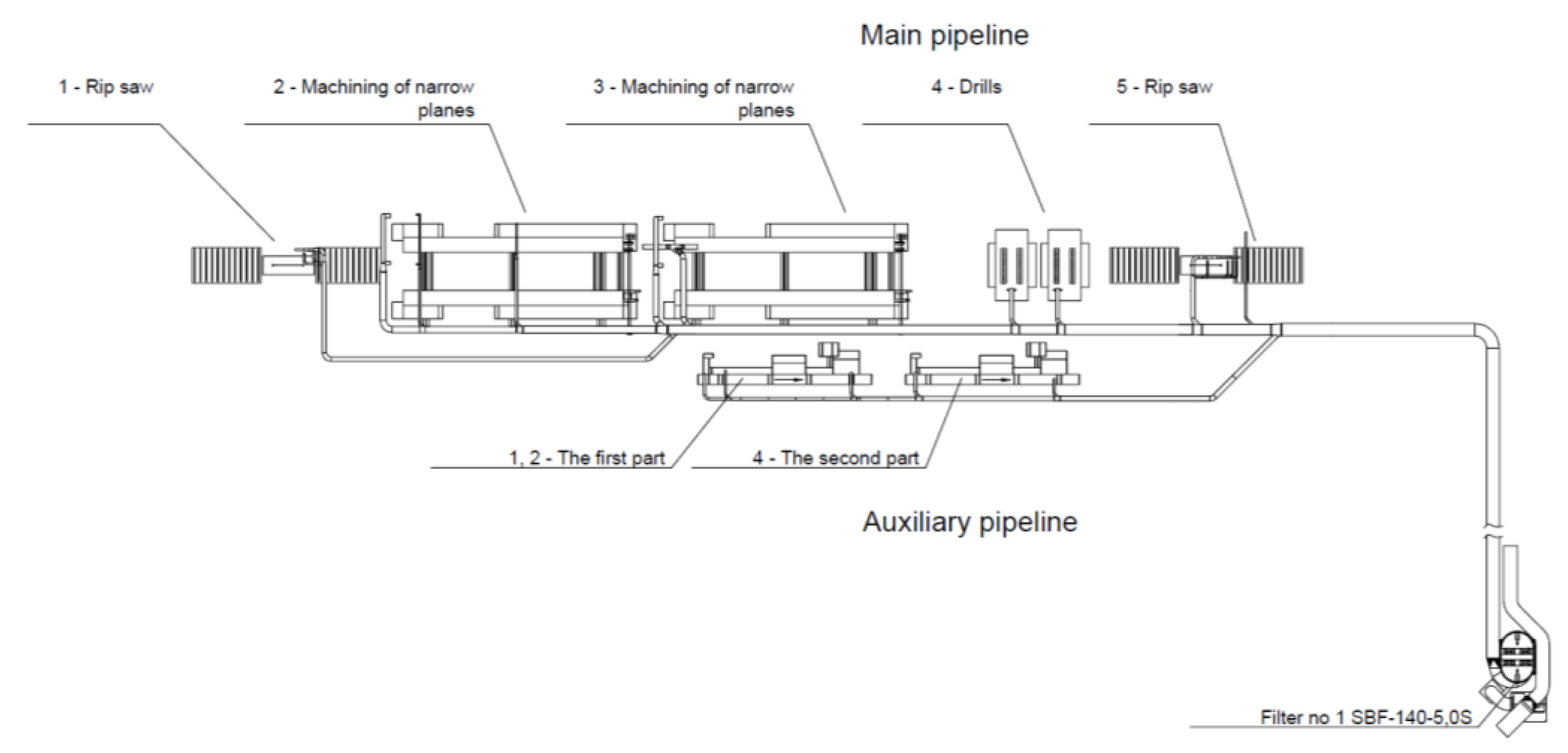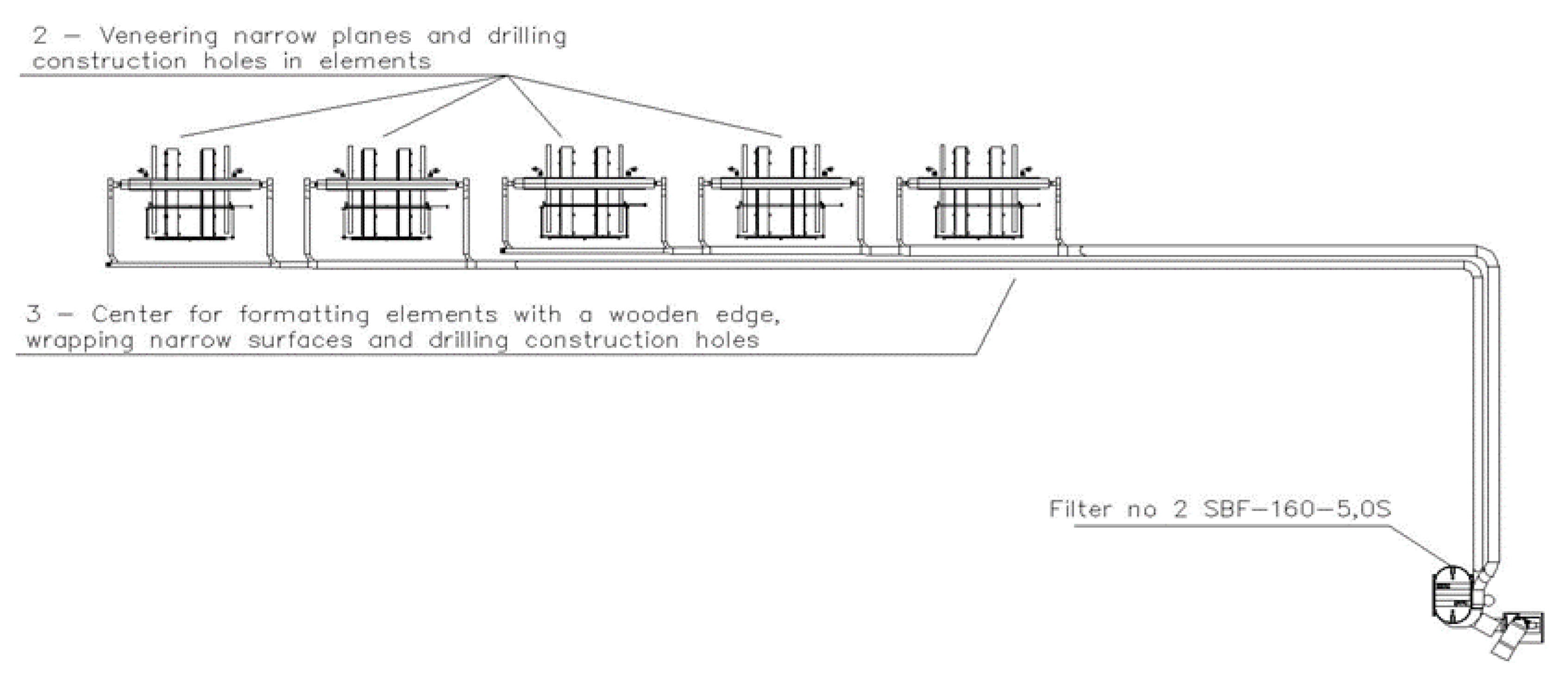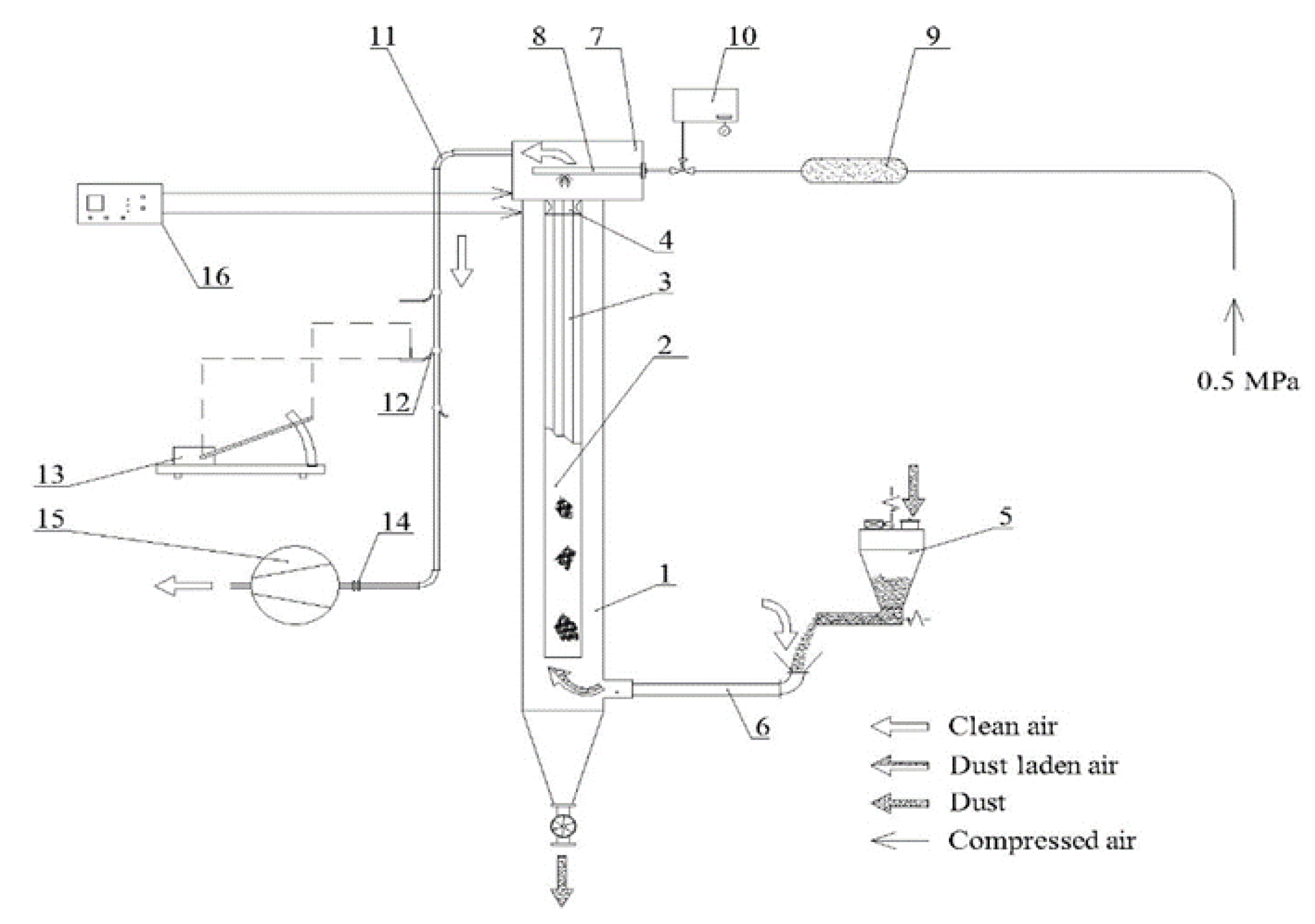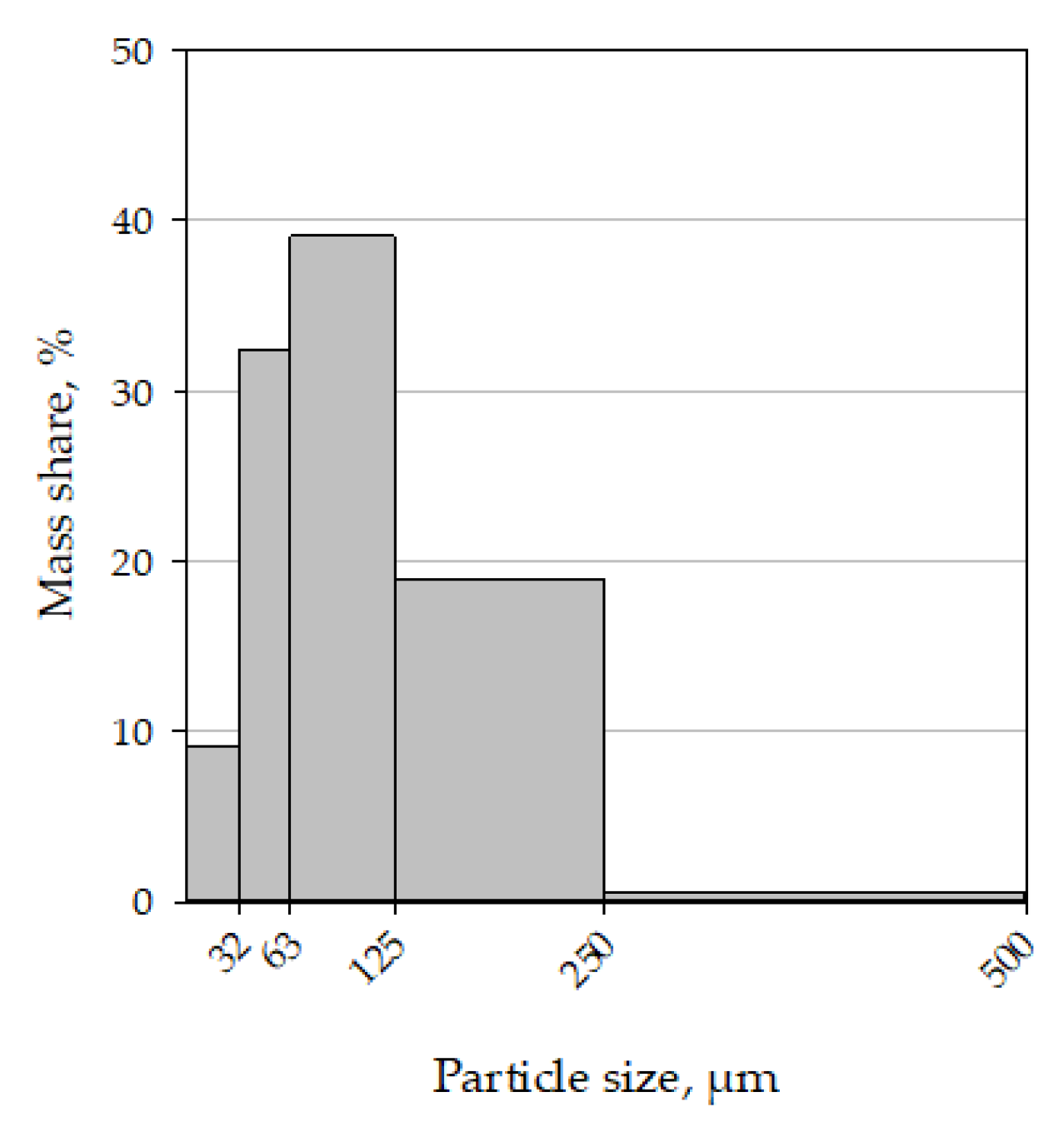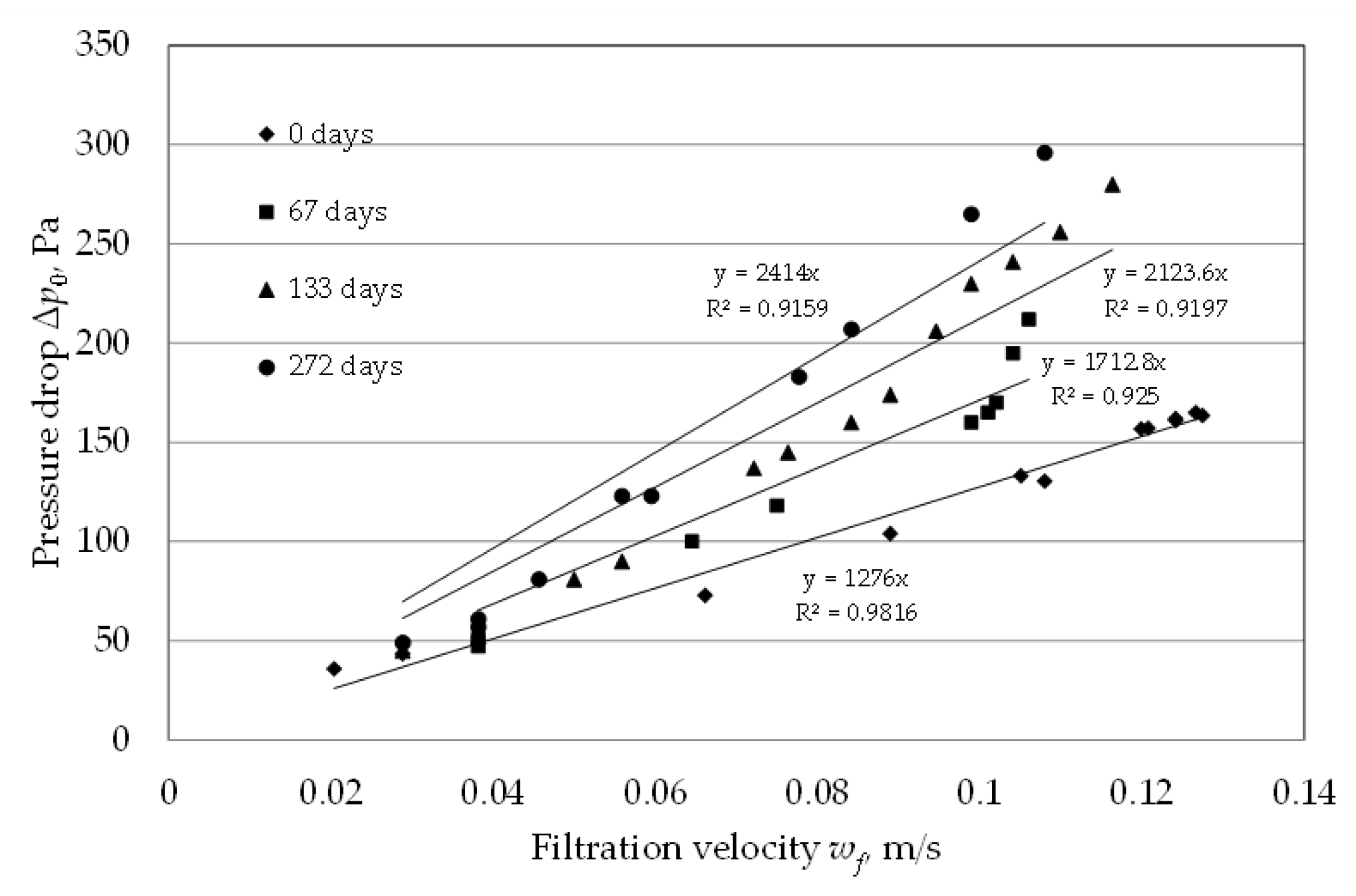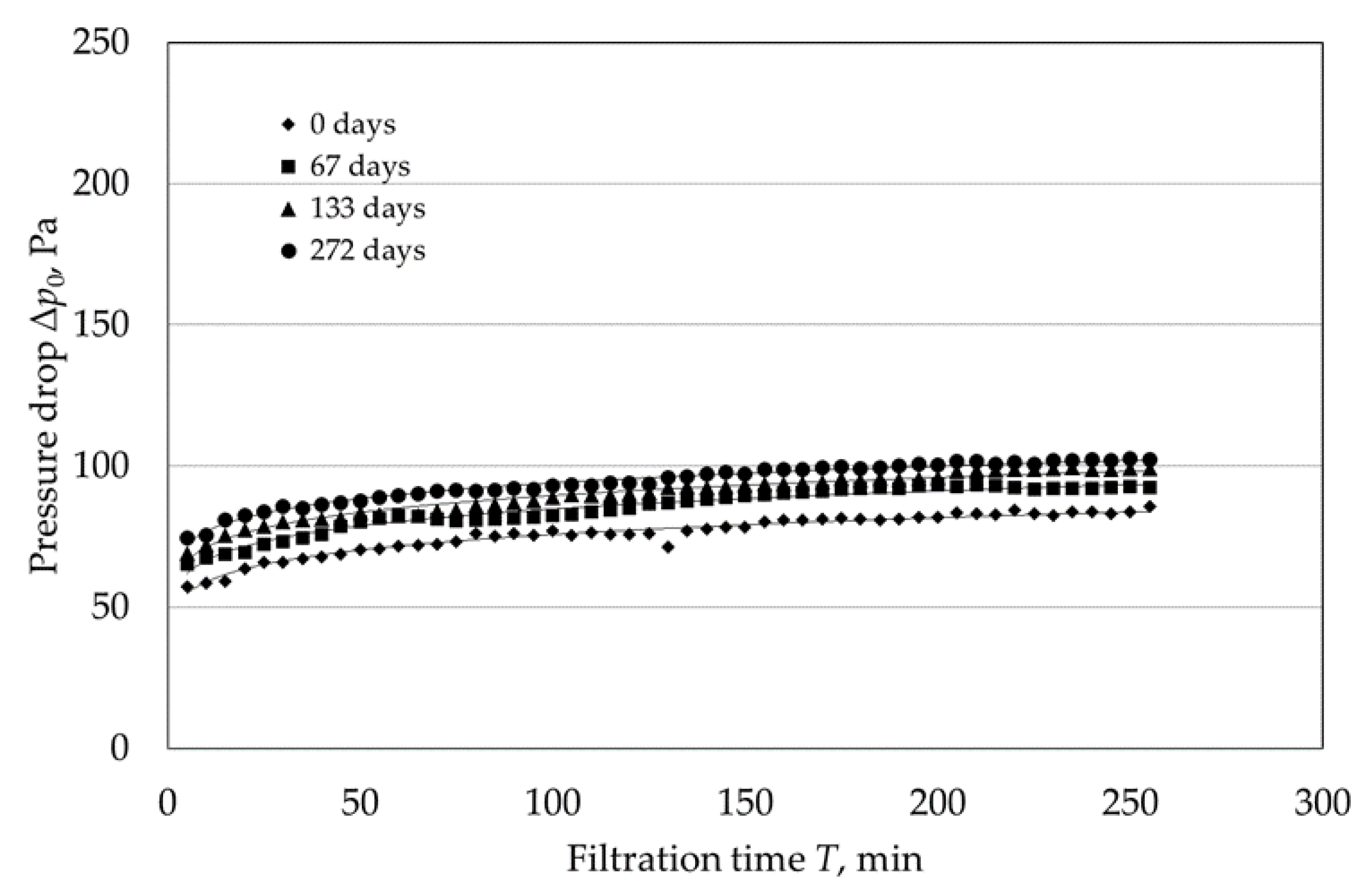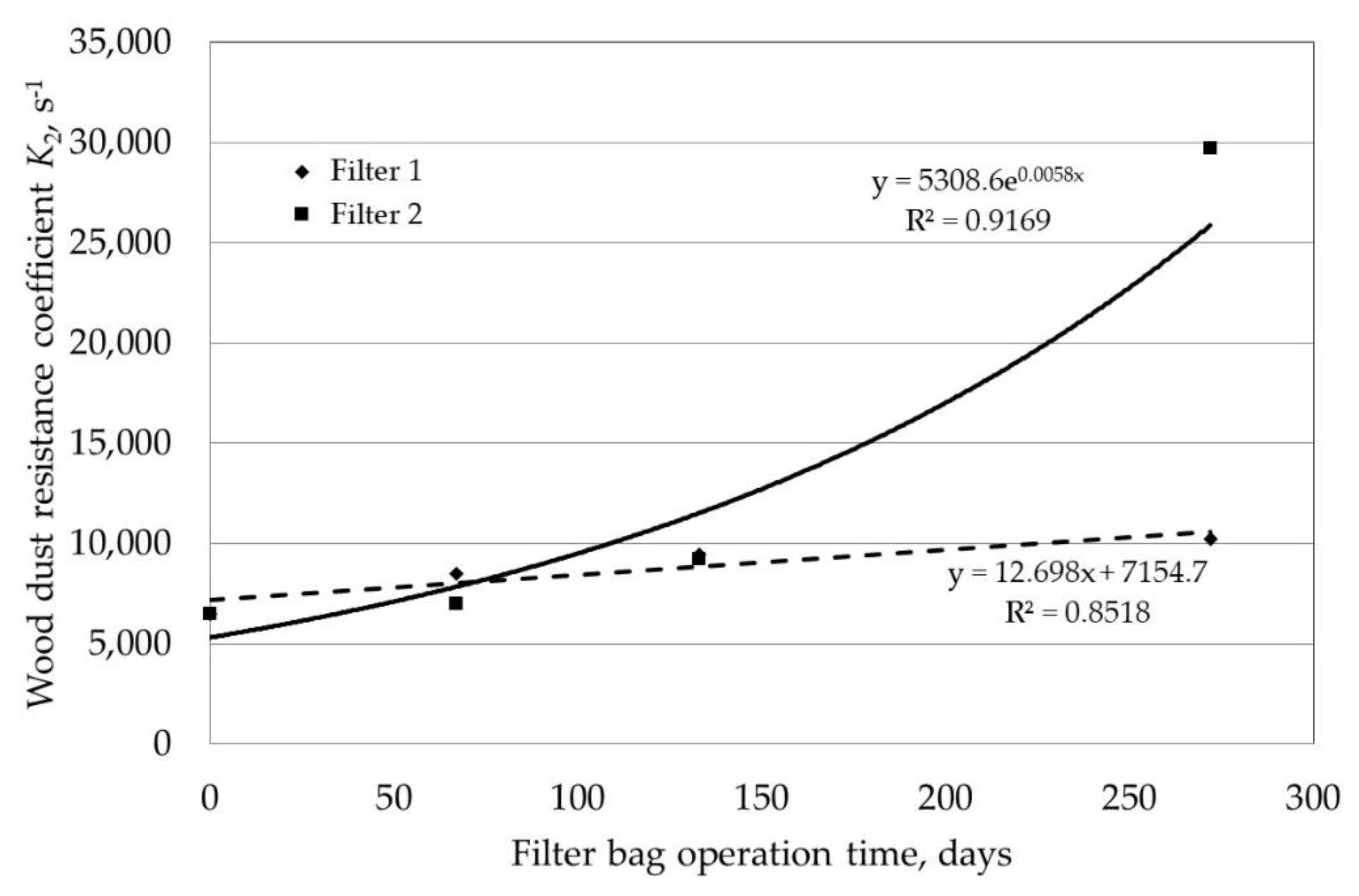1. Introduction
Wood dust dispersed in the air at processing stations causes deterioration of working conditions in the wood industry. Occupational exposure to hardwood and mixed wood dust can cause cancers of the nasal cavity, paranasal sinuses, and nasopharynx as well as various human health problems, including skin, nose, and eye irritation, asthma, and allergic reactions [
1,
2,
3,
4,
5]. This is because wood dust has been recognized as a carcinogenic substance and, therefore, a limit of the permissible dust concentration of air has been set. Wood dust has been classified as carcinogenic to humans (Group 1) by the International Agency for Research on Cancer (IARC) [
6]. According to European requirements, the limit is currently 3 mg·m
−3 or 2 mg·m
−3 (oak and beech), and from 19 January 2023, this limit will be tightened to 2 mg·m
−3 [
7]. Therefore, filtering dust collectors operating in filtering installations in wood plants must be characterized by separation efficiency ensuring air purity required in the recirculation cycle. For these reasons, it is necessary to carefully select and control the operating conditions of filter dust collectors for wood dust, so that the required separation efficiency does not cause excessive air flow resistance [
8,
9,
10,
11,
12,
13,
14,
15]. Each increase in the air flow resistance is associated with an increase in energy consumption to overcome this resistance, which generates additional operating costs [
16].
The air flow resistance through a filter is reflected by the total pressure drop Δp
c which consists of the pressure drop Δp
0 across the clean filter fabric, and the pressure drop Δp
p across the dust cake formed on this material [
17,
18,
19]. They can be calculated from Formula (1).
The pressure drop across the clean filter fabric is calculated by multiplying the filtration velocity w
f by the K
0 coefficient defined as the clean fabric resistance coefficient according to Formula (2).
During dust filtration, dust is deposited on the surface of the filter medium in a dust cake, causing an increase in air flow resistance. The value of the pressure drop across the dust cake depends on many factors, such as, for example, the volume of air flowing into the filter, the amount and type of dust, or the pulse-jet cleaning parameters that determine the thickness of the dust cake. Thus, the pressure drop across the dust cake accumulated on the filtering surface depends on the filtration speed w
f, the dust load of the filter medium surface, and the dust resistance coefficient in accordance with Formula (3):
where: w
f—filtration velocity, s—dust deposit areal density, K
2—dust cake resistance coefficient.
Coefficient K
2 reflecting individual properties of the dust cake on the surface of the filter medium can only be determined experimentally. The research conducted so far has usually concerned a short-term process of air filtration in laboratory conditions, in which a clean filter fabric or artificially aged media were used, often in small-scale research equipment and the samples of filter media used [
20,
21,
22]. Given the growing problem of polluted air, there is a growing need not only to design and improve dust separation technology, but also to extend the research to include methods that refer to the actual sources of pollution. This generates the need to use research material used in the real conditions of the wood industry.
So far, ceramic dust [
23], limestone [
24,
25,
26], fly ash [
21,
22,
25], and coal dust [
27,
28,
29] have been subjects of the study of filtration processes, or wood test dusts [
30,
31] which are finer and more uniform in size and shape compared to wood dust produced under real production conditions in woodworking factories. For this reason, the results of these studies are not sufficient to fully understand the phenomena occurring during the filtration of wood dust from the wood industry and cannot be related to the filtration of this dust. Bearing in mind the above, there was a need to use wood dust generated as processing waste in wood factories as a research material in the study of filtration processes. It is especially important to take into account the influence of a dust cake made of such dust on the filter medium in order to evaluate the effects of long-term filtration in industrial conditions. The assessment of the course of the filtration process and changes in the properties of the filter medium operating in industrial conditions for a long period of wood dust separation should be confirmed by the objectivity of laboratory tests results. Filter bags operating in industrial conditions, in contrast to laboratory-aged bags, are exposed during operation to the impact of industrial waste dust with a diversified dimensional structure and, depending on the conditions of their formation, also differing in terms of particle shape. An additional difference between the laboratory and industrial aging of the filter medium is its operation in changing climatic conditions over a longer period of time, taking into account temperature changes and humidity of the filtered air. The bags used in previous studies were conditioned in strictly defined laboratory conditions with the use of specialized chambers in which the filter material was subjected, depending on the test method, from 2500 up to 10,000 filtration cycles under constant climatic conditions [
21,
32,
33,
34].
Therefore, to compare the influence of various operating conditions of filter bags in filter baghouses for wood dust on their operational properties, we use a reference dust that would not differ from industrial dusts. In order to compare the dust resistance coefficient during the filtration processes, it was decided to carry out an experiment with use of the filter bags obtained after long-term operation from two different filtering installations operating in one furniture factory.
3. Results and Discussion
Filter bags from two installations operating in the same furniture factory in different technological lines were used for the test. Thus, data were obtained on the characteristics of the formation of air flow resistance through bags made of the same non-woven fabric installed in filters differently loaded with air carrying various types of dust waste.
Before testing the total pressure drop Δp
c for individual bags, the pressure drop across the bags Δp
0 during the clean air flow was determined. This test showed an increase in resistance with increasing bag life in an industrial filter. The pressure drop values for the filter bags from both filter baghouses are shown in
Figure 5 and
Figure 6. The formation of the pressure drop during the flow of clean air through the filter bags is very similar to the results obtained in previous studies on the use of two-layer filter media for the separation of wood dust [
26].
The value of the K0 coefficient equal to 1276 [Pa·s·m−1] was read from plot of the clean bag, which had not been used before, as the value of the proportionality coefficient of the regression equation. On the basis of the results obtained in accordance with the Formula (1), the value of the pressure drop across the clean bag Δp0 was calculated for the assumed filtration velocity of 0.0405 m·s−1. This pressure drop is 51.7 Pa. This value was further used to determine the dust cake resistance coefficient.
The operation time of the bags in an industrial installation increases the resistance of clean air flow through the tested filter fabric. This is certainly due to the presence of dust inside the bag structure that was previously used in an industrial dust collector. Higher resistances were obtained for the bags working in filter 2 in the dust extraction installation of the CNC drilling machine line. The pulse-jet baghouse in this installation works in lighter conditions (filtration velocity and less waste than in the narrow surfaces processing line) and the bags are cleaned less frequently. This shows that the frequency of cleaning pulses has a decisive influence on the air flow resistance.
In the second stage of the test, the total pressure drop was measured during the experiments with the use of filter bags previously working in industrial filters for 67, 133 and 272 days and a clean bag, not previously used. The same test wood dust was used in all the experimental air purification processes.
Figure 7 and
Figure 8 show the maximum pressure drop Δp
c in individual filtration cycles for the tested filter bags from baghouses 1 and 2 respectively. Both figures show the pressure drop curves for bags that were used in industrial installations. The course of the increase in total pressure drop during experimental filtration processes is characteristic for this type of filtration process.
In the initial phase, the pressure drop increases quite quickly, but with the time of the experiments, the increase in the pressure drop gets smaller. This proves the stabilization of the dust cake formed on the surface of the filter medium and thus the stabilization of the flow conditions in the entire system.
For bags from both lines it was observed that the longer the fabric was used in the industrial installation, the higher the air flow resistance during laboratory tests. Comparing both lines, it can be concluded that slightly higher resistances were observed for the bags of the CNC drilling machine line. However, in the case of the longest operation life of 272 days, this difference was significant.
Based on the regression equations for pressure drop obtained in individual test filtration processes, the values of the total pressure drop for the 50th filtration cycle were calculated. The equations and values of Δp
c are presented in
Table 5. The total pressure drop difference of the bags from the filter 1 and from the filter 2 were statistically significant for the 67th day and 272nd day. However, the absolute difference was much greater for the 272nd day.
Using the Δp
c value from
Table 5, the values of the K
2 dust resistance coefficient were calculated based on Formula (4) for all test processes. The results of these calculations are presented in
Table 6.
Figure 9 shows the dependence of the K2 coefficient on the operation time of the bags in the installation in both lines.
Based on the results obtained, differences in the value of the K
2 coefficient were observed. Extending the operation time of bags in industrial installations increases the K
2 coefficient from 6400 s
−1 to over 10,100 s
−1 in the case of narrow surface processing line (filter 1) to almost 30,000 s
−1 in the case of CNC drilling machines line (filter 2). Higher values of the K
2 coefficient were obtained for the CNC drilling machine line, in which the bags operating in the industrial installation were less loaded with dust and the dust particles were coarser. The factor that determines the value of the K
2 coefficient is the frequency of cleaning pulses. In the filter in the narrow plane processing line, where the frequency of cleaning pulses is higher, lower values of the K
2 coefficient were obtained, even though the dust load of these bags in the industrial installation are much heavier. The values of parameters summarizing the working conditions of the bags in industrial installations and the results of the dust resistance coefficient are presented in
Table 7.
The results obtained show that cleaning pulses are an important factor determining the work of filter bags. They can eliminate the potentially negative impact on the filtration process of other factors, such as dust load or particle size of dust in polluted air.
Comparing the results obtained with the earlier studies in which the values of the K
2 coefficient for beech dust were determined, it can be concluded that in the case of this filter material, the values of the K
2 coefficient for beech wood dust are about half that of the values obtained in the study on wood dust filtration [
30]. In these tests, however, a filter material with a higher weight was used and the intervals between the cleaning pulses were much smaller. In other works describing the filtration tests, taking into account the determination of the K
2 coefficient value, mineral dusts were usually used. Choi [
35] calculates the dust resistance coefficient for fly ash with three different values of the geometric mean diameter (dust from: power plant 19.15 µm, fluidized bed combustion 45.68 µm and paint incinerator 37.55 µm). This dust is much finer than wood dust, hence the K
2 coefficient values are much higher and range from 120,000 s
−1 to over 300,000 s
−1. Saleem et al. [
25]. Cheng and Tsai [
24] dealt with, inter alia, filtering separation of limestone dust. For this type of dust, at a similar filtration velocity, the values of the K
2 coefficient are also much higher than for wood dust. Moreover, the study of the filtration of limestone dust and fly ash carried out by Cheng and Tsai [
24] showed a directly proportional increase in the K
2 coefficient depending on the filtration velocity. Saleem, et al. [
25] came to similar conclusions.
The study on the K
2 coefficient during the filtration of coal dust was carried out by Li, et al. [
28]. In this case, the focus was on the influence of dust humidity on the filtration resistance caused by the dust cake and the K
2 coefficient. The test carried out at similar velocities showed that the value of the K
2 coefficient reaches up to about 1.3 × 10
8 and is definitely higher than in the case of filtering wood dust. It is also highly dependent on the moisture content of the dust.
Studies on the K
2 coefficient during filtration, as a rule, concerned research based on mineral dusts. In the available publications, one can also find works on organic maize and tapioca dust in comparison to mineral dust in the form of phosphate concentrate [
36]. The research concerned the porosity of the dust cake formed on the filter surface. The results obtained clearly indicate that the porosity of the dust cake depends, inter alia, on the particle size (the smaller the particle size, the lower the porosity, and the higher the cake density) and the filtration velocity. Therefore, a directly proportional increase in the K
2 coefficient was shown depending on the increase in the density of the dust cake and inversely proportional to its porosity. The effect of increasing the filtration velocity on the value of the K
2 coefficient during filtration has also been proven. The values of the K
2 coefficient obtained for individual dusts at the filtration velocity of 5 m·s
−1 were: 74,000 s
−1 for tapioca dust, 16,000 s
−1 for corn dust and 23,200 s
−1 for phosphate concentrate dust. When analyzing the particle size and dust density, we conclude that these parameters also affect the K
2 coefficient. Among the three tested dusts, the density of tapioca and corn and the particle size were similar (density about 1.5 g·cm
−1, particle size from 8.5 to 9.5 µm). For the dust from the phosphate concentrate, these values were: density about 3.03 g·cm
−3, particle size 15.53 µm. Analyzing the obtained values of the K
2 coefficient for individual types of dust, we have come to the conclusion that one of the factors shaping its value is also the dust density. It was found that the dependence of the K
2 coefficient value is directly proportional to dust density. Kim et al. (2019) did not study the dust specific resistance coefficient in rice dust in post-harvest processes due to the various particle sizes and low dust concentrations [
37].
The presented diagrams (
Figure 7 and
Figure 8) clearly show the dependence of the filtration resistance on the bag’s working time in the baghouses operated in the dust exhaust installations in the narrow surface processing and the line of CNC drilling machines. The longer the working time of the filter bags, the greater the resistance. This is also confirmed by the diagram of the resistance of clean air flow through the filter and the related value of the K
2 coefficient increasing with working time of material. It follows that the operation time (maturation, conditioning) of the filter bags affects the formation and the value of the K
2 coefficient. The pulse-jet cleaning intensity is associated with the working time, it turns out that the filter bags cleaned more frequently retaining lower flow resistance despite the greater load of finer dust. The effective pulse-jet cleaning of filter bags is dependent on the specific dust resistance coefficient. The studies performed using limestone dust and fly ash show that the increase of the K
2 coefficient requires higher cleaning parameters [
38,
39].
Long-term operation of the filter bags can be simulated under laboratory conditions. The methods of aging filter materials in laboratory conditions, used so far by Saleem, et al. [
20] and Mukhopadhyay and Bawane, (2015) [
21] corresponded to the number of cleaning pulses for a period of approximately 100 days of bag work in a furniture factory (maximum 10,000 cycles), while the operation life of such bags is often several years. As a result, such artificial aging of filter bags may turn out to be unreliable; therefore, to verify the actual operation of such bags, they must be tested taking into account their use in real conditions.
